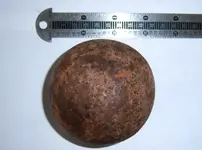Jon A. wrote:
> And if it is a cannonball, what type gun would shoot it?
Here's some basic information, to answer your question, for anybody else here who doesn't already know:
Cannonballs were for use in Muzzle-Loading cannons. Muzzle-loading means the ammunition was loaded into the front end of the barrel, which is called the muzzle.
You'll notice that the Ordnance Department's cannonball size-specifications (
www.civilwarartillery.com/shottables) are extremely precise ...the ball diameters are specified in hundredths-of-an-inch. (Examples are 1.95-inches, 2.84-inches, 3.12-inches, etc.) You may be wondering why the diameter size-specification is THAT precise. The answer is, a cannonball MUST fit fairly tightly/snugly inside the cannon's bore (the long tunnel inside the barrel is called the "bore"). If the ball is even 5 hundredths-of-an-inch smaller than it should be, a significant amount of the cannon's firing-blast will escape through the gap between the ball and the cannon's bore, and that causes the ball to not shoot as far as it is supposed to go. If the cannonball fits in the cannon's bore too loosely, it will "fall short" when fired, and you will never be able to hit the target you are aiming at. Therefore, ALL cannonballs were carefully manufactured to be the VERY-EXACT diameter-size specified (such as 2.84" or 3.12", or 4.52", etc) for the cannon they were to be used in.
A cannonball's VERY-EXACT weight is just as important as its size. That is why the Ordnance Department specified a very-exact weight (such as 3.05 pounds, 4.07 pounds, 12.25 pounds, etc). If some of the balls for your cannon weigh even a few ounces less than others, they won't shoot the same distance as the others ...and again you're going to have a lot of trouble hitting the target you are aiming at.
Jon A. also wrote:
> They tell me the ball weighs 3 lbs. 13.8 oz.
First, two sidenotes:
1- The "pounder" designation (3-Pounder, 6-Pounder, 9-Pounder, etc) of a cannon's caliber is the weight of a Solid Shot projectile for that particular caliber of cannon.
2- Solid Shot means the projectile is solid through-and-through, not a hollow-bodied explosive projectile (which known as a Shell).
Checking the cannonball diameter-&-weight chart at
www.civilwarartillery.com/shottables.htm for the "closest match" to your ball... it is too heavy to be a "3-pounder caliber" cannonball (2.84" diameter, 3.05 pounds) ...and too light to be a "4-pounder caliber" cannonball (3.12" diameter, 4.07 pounds). Note, there are no cannonballs in between those sizes. So, the outlook isn't good for your ball being a cannonball.
That being said... sometimes, air bubbles accidentally got trapped inside the molten iron when the cannonball was being cast. Those "casting flaw" air bubbles inside a cannonball can cause it to be a FEW ounces lighter than the manufacturer intended it to be. Your ball is only 3 ounces lighter than a 4-pounder caliber cannonball ...so, MAYBE it is a 4-pounder with casting-flaw air bubbles inside it.
Fortunately, there is a way to find out with CERTAINTY whether it is or isn't a "flawed" 4-pounder caliber cannonball. As mentioned above, a 4-pounder caliber cannonball is specified to be 3.12-inches in diameter. Please buy or borrow a set of Digital Calipers (which measure in hundredths-of-an-inch) to check your ball's very-exact diameter. If your 3-pound 14-ounce ball measures within two hundredths of 3.12-inches (3.10 to 3.14-inches), it is a "flawed" 4-pounder caliber cannonball. If it isn't between 3.10 and 3.14-inches, it is not a cannonball.
Sidenote:
Fortunately, in the 21st-Century, the price of Digital Calipers has become very inexpensive. You can buy them for less than $20 at Home Depot, or Harbor Freight Tools, or online at Ebay. They are worth that small amount of money for a relic-digger or collector to own ...because Digital Calipers are also useful for precisely measuring the size of bullets, coins, buckles, and buttons. Take this advice, please... knowing the very-exact size can be hugely important for correctly identifying those kinds of relics -- not just cannonballs.





